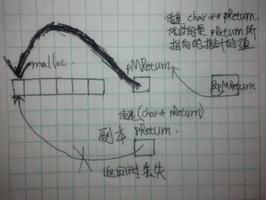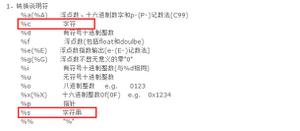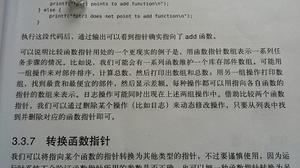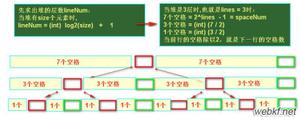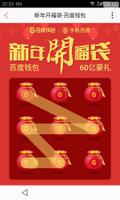C++中函数指针详解及代码分享
函数存放在内存的代码区域内,它们同样有地址。如果我们有一个int test(int a)的函数,那么,它的地址就是函数的名字,如同数组的名字就是数组的起始地址。
1、函数指针的定义方式:data_types (*func_pointer)( data_types arg1, data_types arg2, ...,data_types argn);
c语言函数指针的定义形式:返回类型 (*函数指针名称)(参数类型,参数类型,参数类型,…);
c++函数指针的定义形式:返回类型 (类名称::*函数成员名称)(参数类型,参数类型,参数类型,….);
例如: int (*fp)(int a); //这里就定义了一个指向函数(这个函数参数仅仅为一个int类型,函数返回值是int类型)的指针fp。
类成员函数指针与普通函数指针不是一码事。前者要用.*与->*运算符来使用,而后者可以用*运算符(称为“解引用”dereference,或称“间址”indirection)。
普通函数指针实际上保存的是函数体的开始地址,因此也称“代码指针”,以区别于C/C++最常用的数据指针。
而类成员函数指针就不仅仅是类成员函数的内存起始地址,还需要能解决因为C++的多重继承、虚继承而带来的类实例地址的调整问题,所以类成员函数指针在调用的时候一定要传入类实例对象。
函数指针示例
#include <stdio.h>
#include <stdlib.h>
int fun1()
{
printf("this is fun1 call\n");
return 1;
}
void fun2(int k, char c)
{
printf("this is fun2 call:%d %c\n", k, c);
}
int main()
{
int (*pfun1)() = NULL;
void (*pfun2)(int, char) = NULL;
int a,b;
pfun1 = fun1; //第一种赋值方法
a = pfun1(); //第一种调用方法(推荐)
printf("%d\n",a);
b = (*pfun1)();//第二种调用方法
printf("%d\n",b);
pfun2 = &fun2;//第二种赋值方法(推荐,因为和其他数据指针赋值方法一致)
pfun2(1,'a');
(*pfun2)(2,'b');
return 0;
}
函数指针作为函数参数:
#include <stdio.h>
#include <stdlib.h>
void fun(int k, char c)
{
printf("this is fun2 call:%d %c\n", k, c);
}
void fun1(void (*pfun)(int, char), int a, char c)
{
pfun(a, c);
}
int main()
{
fun1(fun, 1, 'a');
return 0;
}
// c++ 的形式差不多
函数指针作为函数返回值:
// c 形式
#include <stdio.h>
#include <stdlib.h>
void fun(int k, char c)
{
printf("this is fun2 call:%d %c\n", k, c);
}
//fun1 函数的参数为double,返回值为函数指针void(*)(int, char)
void (*fun1(double d))(int, char)
{
printf("%f\n",d);
return fun;
}
int main()
{
void (*p)(int, char) = fun1(3.33);
p(1, 'a');
return 0;
}
//c++ 形式
#include <iostream>
using namespace std;
class test
{
public:
int fun(int a, char c)
{
cout<<"this is fun call:"<<a<<" "<<c<<endl;
return a;
}
};
class test2
{
public:
// test2 的成员函数fun1,参数是double,
//返回值是test的成员函数指针int(test::*)(int, char)
int (test::*fun1(double d))(int, char)
{
cout<<d<<endl;
return &test::fun;
}
};
int main()
{
test mytest;
test2 mytest2;
int (test::*p)(int, char) = mytest2.fun1(3.33);
(mytest.*p)(1, 'a');
return 0;
}
函数指针数组:
#include <stdio.h>
#include <stdlib.h>
float add(float a,float b){return a+b;}
float minu(float a,float b){return a-b;}
int main()
{
//定义一个函数指针数组,大小为2
//里面存放float (*)(float, float)类型的指针
float (*pfunArry[2])(float, float) = {&add, &minu};
double k = pfunArry[0](3.33,2.22);// 调用
printf("%f\n", k);
k = pfunArry[1](3.33,2.22);
printf("%f\n", k);
return 0;
}
//c++ 可类比
typedef 简化函数指针类型:
#include <stdio.h>
#include <stdlib.h>
float add(float a,float b)
{
printf("%f\n",a+b);
return a+b;
}
float minu(float a,float b)
{
printf("%f\n",a-b);
return a-b;
}
//用pfunType 来表示float(*)(float, float)
typedef float(*pfunType)(float, float);
int main()
{
pfunType p = &add;//定义函数指针变量
p(3.33, 2.22);
pfunType parry[2] = {&add, &minu};//定义函数指针数组
parry[1](3.33, 2.22);
//函数指针作为参数可以定义为:void fun(pfunType p)
//函数指针作为返回值可以定义为:pfunType fun();
return 0;
}
//c++ 可类比
总结
以上是 C++中函数指针详解及代码分享 的全部内容, 来源链接: utcz.com/z/319466.html

